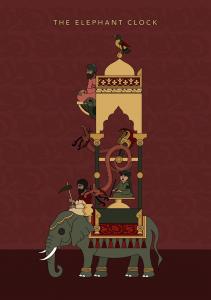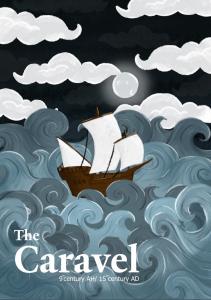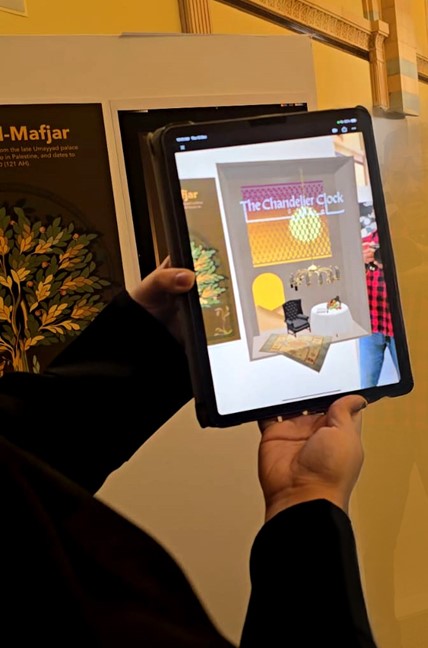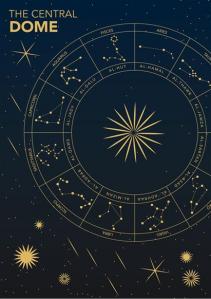University students develop a project that brings Islamic artifacts to life through Augmented Reality

Designed to reflect the multicultural influences of Islamic civilization, the ‘Elephant Clock’ incorporates elements from Indian, Greek, and Chinese engineering traditions. Credit: Farah Bahaaeldin

Among the standout student projects is an AR-enabled poster of The Caravel, a deep-sea European vessel with a distinctive Arabic rig that played a crucial role in medieval trade and navigation. Credit: Naia Rakan
A student-developed Augmented Reality project brings the marvels of Islamic art and heritage directly to our mobile phones
SHARJAH, EMIRATE OF SHARJAH, UNITED ARAB EMIRATES, July 30, 2025 /EINPresswire.com/ -- By Ifath Arwah
Students from the College of Fine Arts and Design (CFAD) at the University of Sharjah have developed an innovative Augmented Reality (AR) project that brings the splendor of Islamic art and heritage directly to your smartphone.
In collaboration with the Sharjah Museum of Islamic Civilization, the students created an immersive AR experience that showcases some of the museum’s most iconic artifacts – ranging from ancient manuscripts and astrolabes to intricately minted coins and the golden-embroidered Kiswah that once draped the Kaaba in Mecca.
The museum itself is a marvel, renowned for its ornate mosaic decorations, zodiac-themed motifs, and a majestic dome that depicts the night sky and the ecliptic path of the zodiac – an awe-inspiring sight for visitors.
The student-led project reimagines how museum collections can be experienced. Using AR technology, they designed a mobile application that overlays digital renderings of Islamic artifacts onto the real world, allowing users to explore the museum’s treasures as if they were physically present.
As part of their coursework, the students were challenged to rethink traditional exhibition methods. Their solution: a series of AR-enabled posters that transform static displays into dynamic, interactive experiences. These posters feature artifacts such as historical ship compasses, the Kaaba, the museum’s central dome, and Al-Jazari’s legendary Elephant Clock.
“When visitors point their mobile devices at these specially designed posters, history comes alive before their eyes,” said Madiha Jamil, CFAD lecturer and project mentor. “Two-dimensional artifacts transform into three-dimensional models, animations reveal how ancient devices functioned, and interactive elements narrate stories from the golden age of Islamic civilization.”
“This fusion of historical artifacts with cutting-edge technology has created a uniquely engaging museum experience,” she added.
As part of an innovative academic project, each student selected a unique Islamic artifact to research, design, and enhance using Augmented Reality (AR) technology. Their work was grounded in rigorous historical research, ensuring that the digital interpretations remained true to the cultural and scientific legacy of the Islamic world.
“We wanted students to engage with these artifacts not just as historical objects, but as stories waiting to be retold in a contemporary way,” said Jamil. “By leveraging AR, they weren’t just designing visuals—they were building bridges between the past and the digital future.”
The project’s impact goes far beyond modernizing museum displays. According to Jamil, it marks a transformative shift in how cultural heritage can be preserved and shared with younger generations. “Young visitors, who might find traditional exhibits static or difficult to relate to, are now actively engaging with history through a medium they understand and enjoy.”
Among the standout student projects is an AR-enabled poster of The Caravel, a deep-sea European vessel with a distinctive Arabic rig that played a crucial role in medieval trade and navigation. Through AR, viewers can access historical insights and detailed information about the ship’s significance,” Jamil explained.
Another remarkable project features The Elephant Clock, a sophisticated timekeeping device invented by 13th-century Muslim engineer Al-Jazari. Designed to reflect the multicultural influences of Islamic civilization, the clock incorporates elements from Indian, Greek, and Chinese engineering traditions. “The student used creative information design to highlight the clock’s intricate mechanisms and historical importance,” said Jamil.
Also included is an AR adaptation of The Chandelier Clock, described in detail by 10th-century astronomer Ali bin Abd Al-Rahman bin Ahmad bin Yunis. Unlike conventional clocks, this device marked time by extinguishing one lamp every hour during the night.
Through the AR interface, visitors can explore a 3D-animated version of the chandelier and experience its unique functionality.
One of the most visually captivating projects centers on The Zodiac and the Dome, a prominent architectural feature of the museum that represents zodiac signs and their roles in Islamic civilization. “The student created an immersive experience that allows users to interact with each zodiac sign and access rich historical context about its cultural and scientific relevance,” Jamil noted.
“These AR-enhanced projects not only brought historical artifacts to life but also created engaging, educational experiences that connect audiences with Islamic heritage in a fresh and meaningful way,” she added.
Beyond the technological innovation, the project has had a profound impact on both students and the museum sector. The Sharjah Museum of Islamic Civilization played an active role in the initiative, with Museum Director Intisar Al-Obaidi and Senior Education Specialist Ruqeya Ahmed Kashwani serving as jury members for the final exhibition.
“Their involvement underscores the serious consideration being given to implementing this technology on a broader scale,” said Jamil. “Our aim was not to replace traditional displays, but to enhance them—creating layered experiences that cater to diverse learning styles and preferences. The goal wasn’t to use technology for its own sake, but to foster meaningful interactions that deepen visitors’ understanding and appreciation of Islamic civilization.”
Following the overwhelmingly positive reception, discussions are underway to integrate the most successful AR projects into the museum’s permanent exhibitions. “Museum authorities have expressed strong interest in adopting the best student projects alongside the original artifacts,” Jamil confirmed. “This initiative has essentially created a blueprint for how cultural institutions can meaningfully incorporate AR into their educational programs.”
LEON BARKHO
University Of Sharjah
+971 50 165 4376
email us here
Legal Disclaimer:
EIN Presswire provides this news content "as is" without warranty of any kind. We do not accept any responsibility or liability for the accuracy, content, images, videos, licenses, completeness, legality, or reliability of the information contained in this article. If you have any complaints or copyright issues related to this article, kindly contact the author above.


